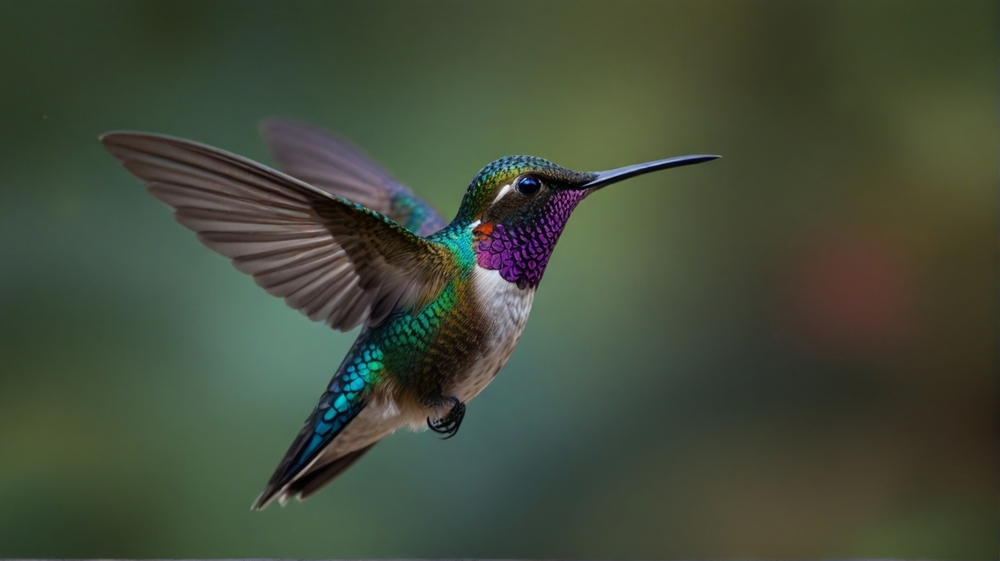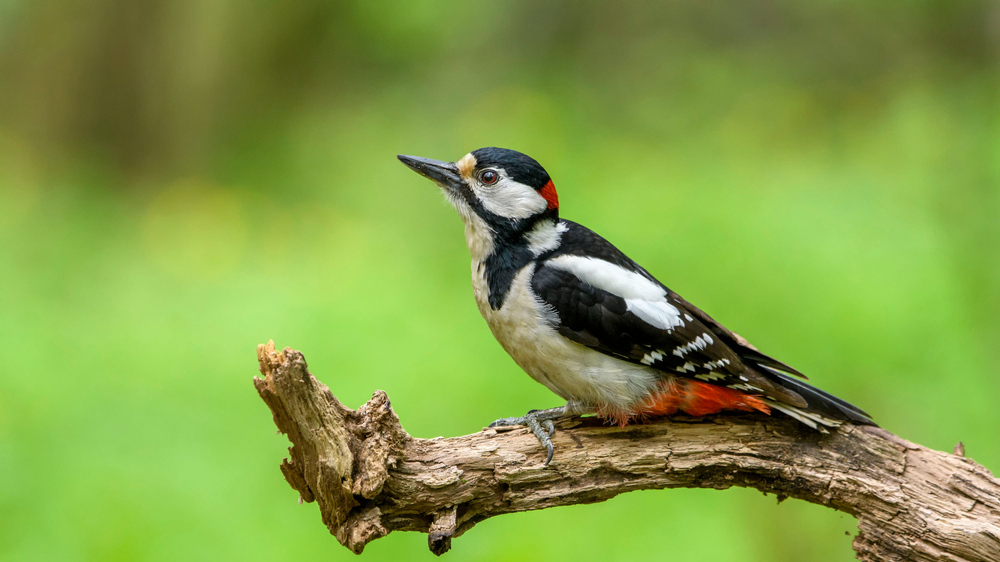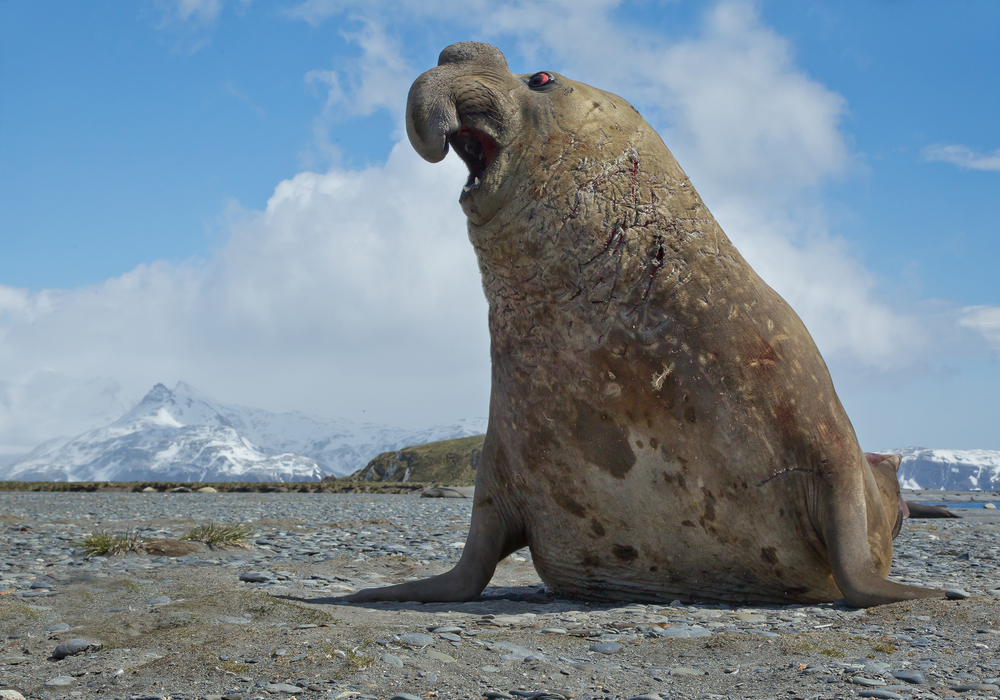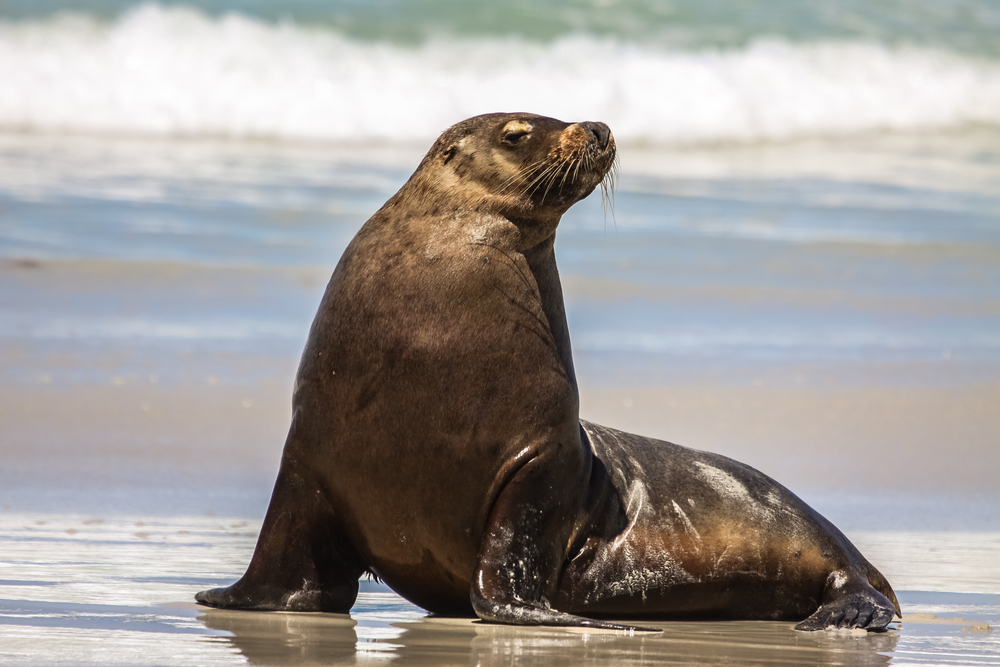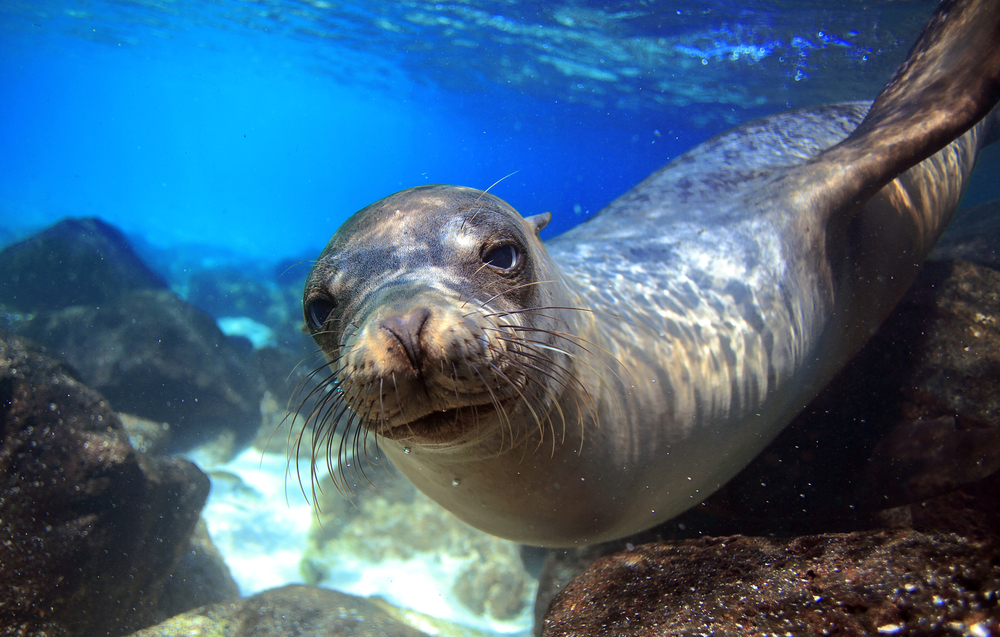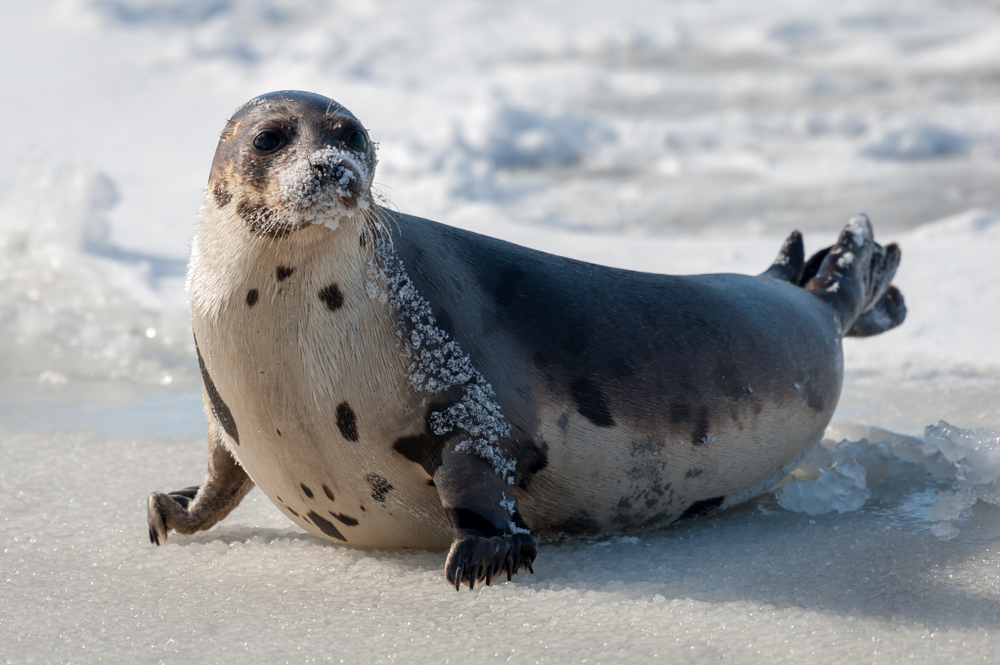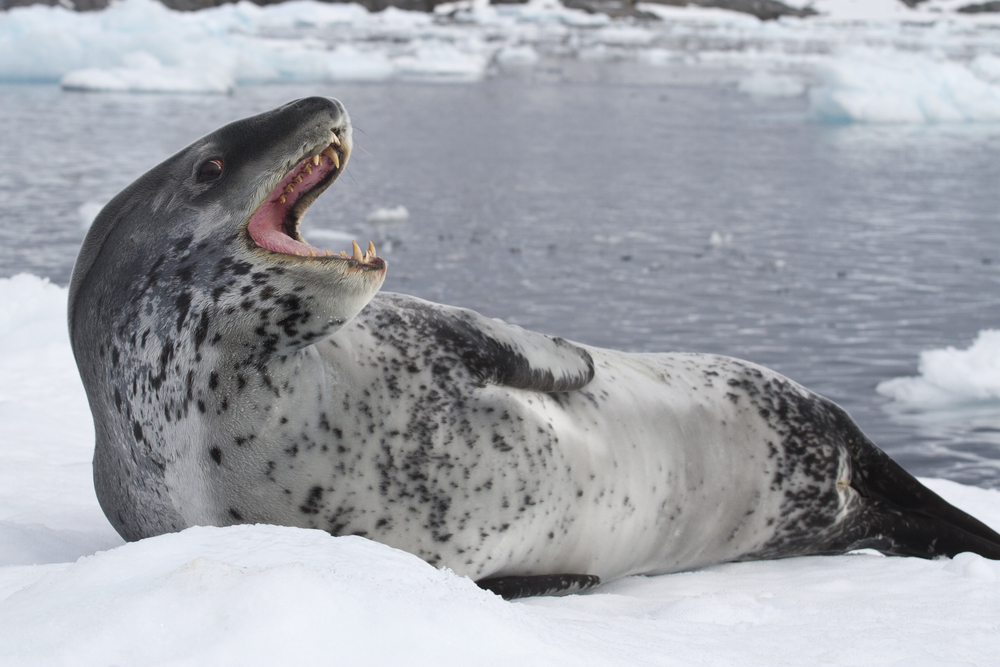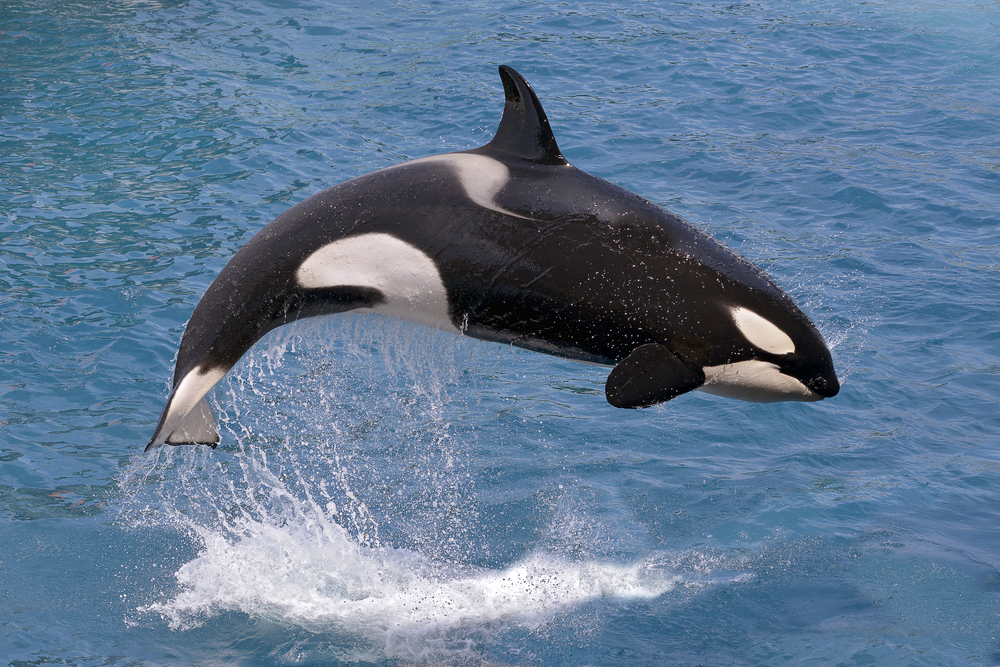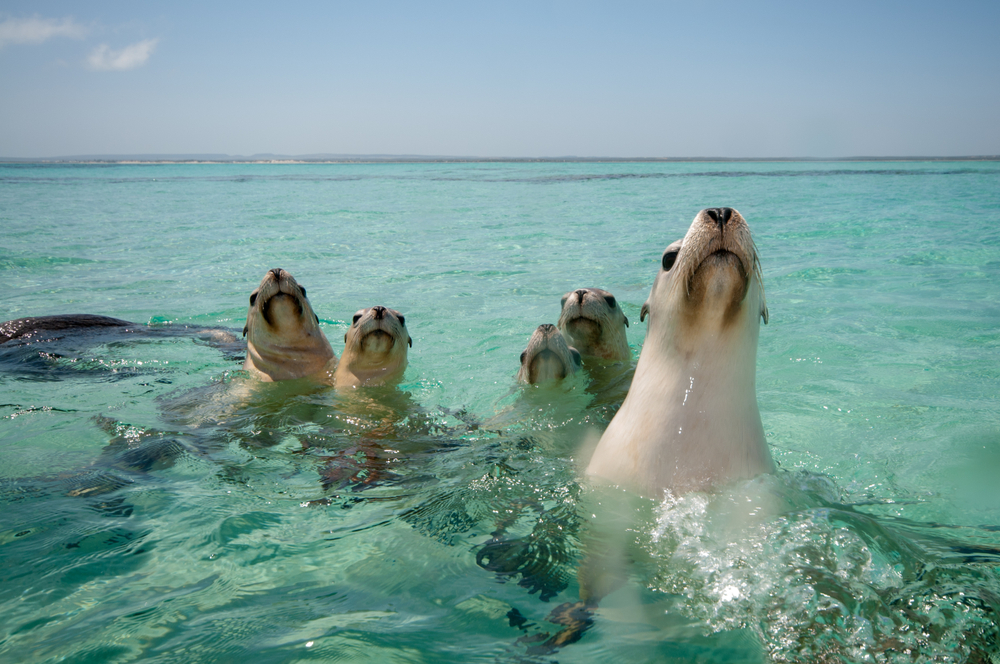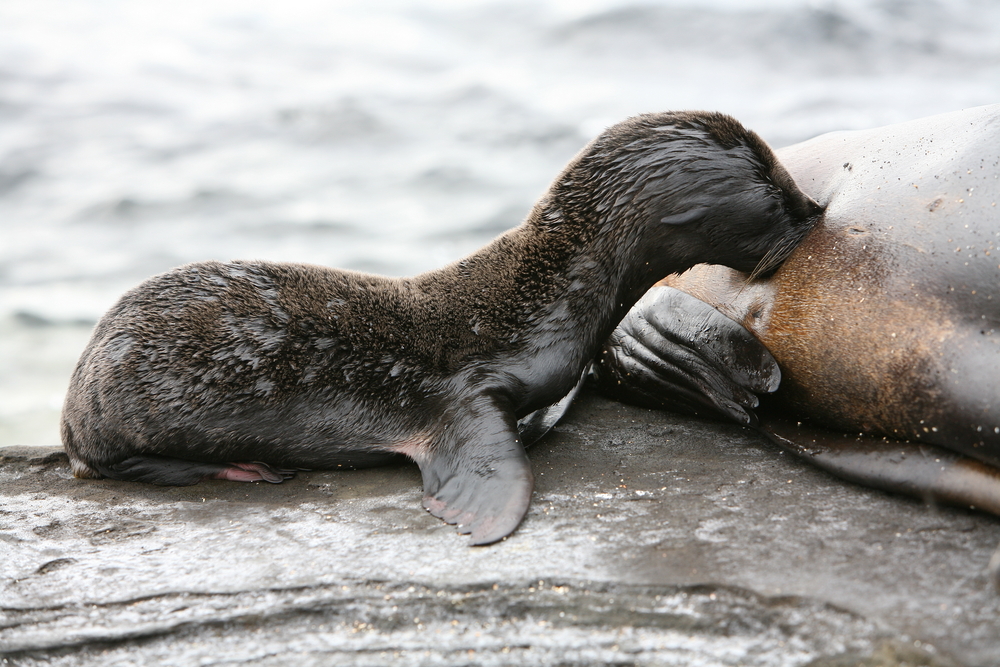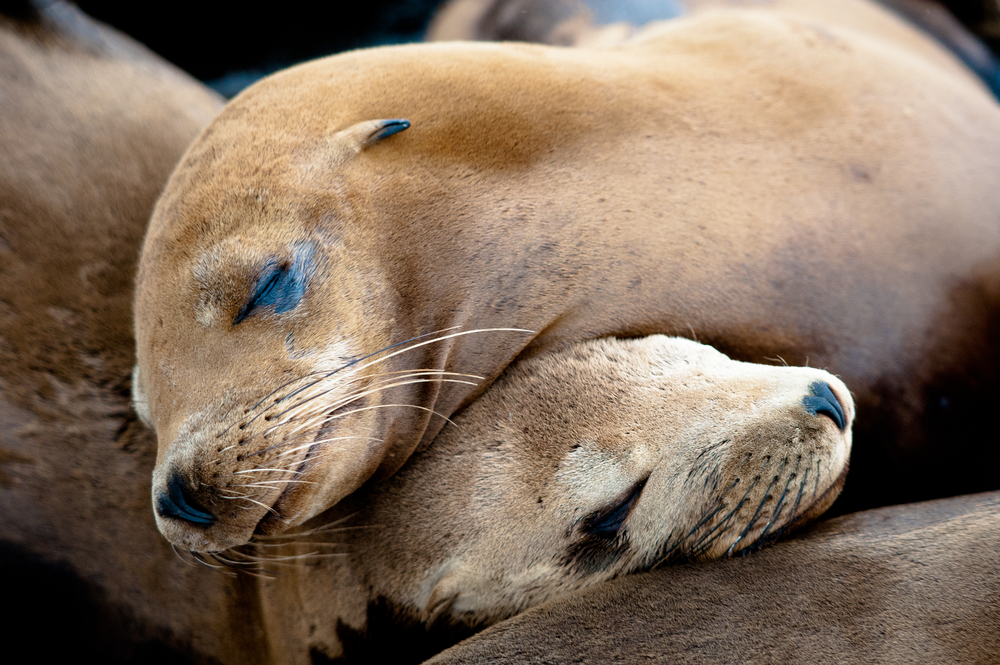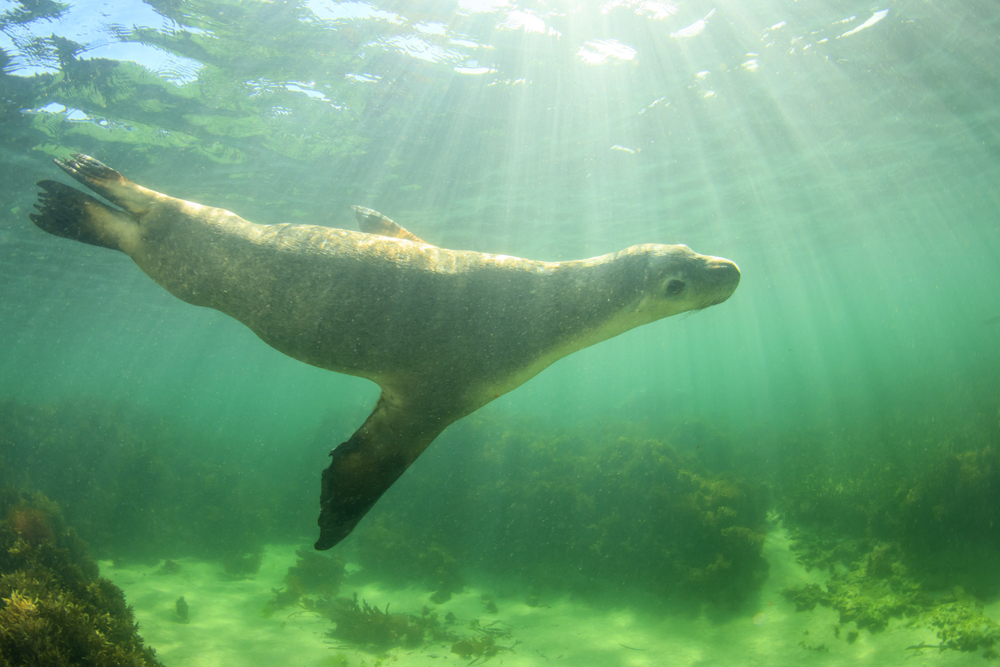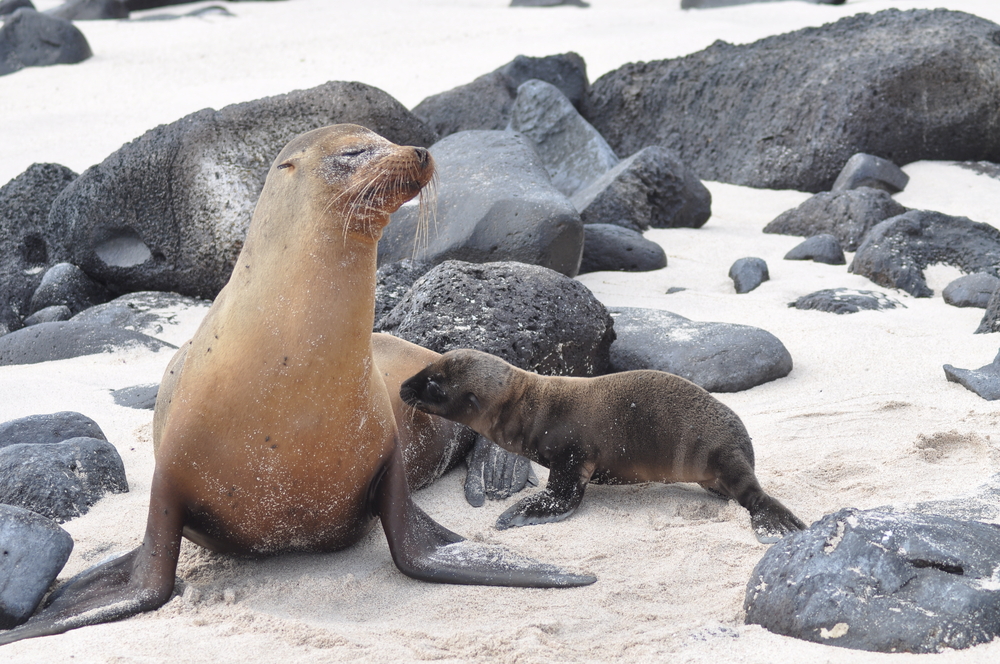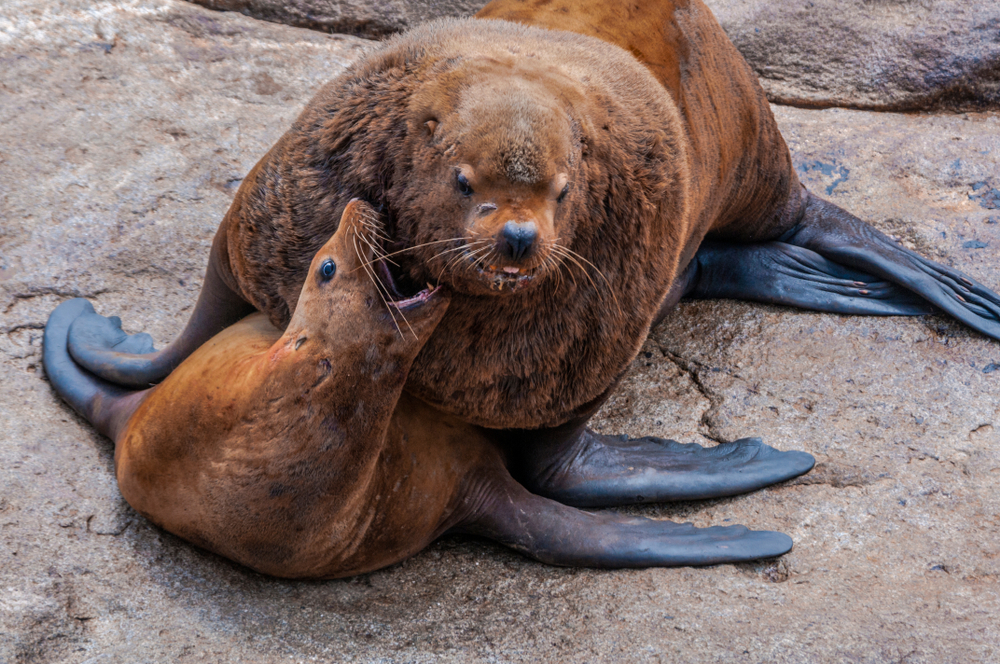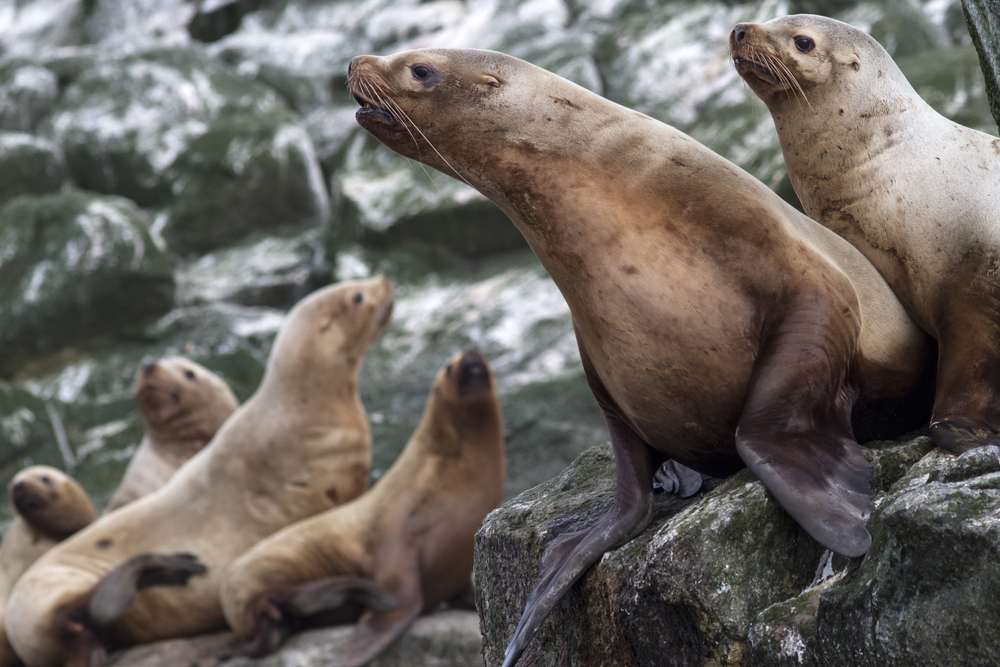About
The Sea Lion, scientifically known as Zalophus californianus, is a marine mammal belonging to the Animal Kingdom’s phylum Chordata and class Mammalia. It is a member of the Otariidae family, which also includes fur seals. Sea lions are found in coastal waters of the North Pacific Ocean, ranging from California to Alaska and across the Bering Sea to Japan.
These charismatic marine mammals are known for their playful and social behavior, often seen basking in the sun on rocky shores or swimming gracefully in the ocean. Sea lions have streamlined bodies, powerful flippers, and a thick layer of blubber that helps them regulate body temperature in cold waters. Adult males, known as bulls, can reach lengths of up to 2.5 meters (8 feet) and weigh over 300 kilograms (660 pounds), while females, or cows, are slightly smaller.
Sea lions are carnivorous predators, feeding primarily on fish, squid, and occasionally crustaceans. They are agile hunters, using their keen senses of sight and hearing to locate prey underwater. Sea lions are also highly vocal animals, communicating with each other using a variety of barks, grunts, and growls.
Conservation Concerns
Sea lions face various conservation concerns, including habitat loss, entanglement in fishing gear, pollution, and human disturbance. Commercial fishing operations often compete with sea lions for fish stocks, leading to conflicts over food resources. Additionally, pollution from oil spills, marine debris, and contaminants threatens their marine habitats.
The California Sea Lion is currently listed as Least Concern on the IUCN Red List, indicating that it does not face immediate extinction risk. However, some populations may be declining due to ongoing threats. Conservation efforts, such as habitat protection, fisheries management, and public education, are crucial for ensuring the long-term survival of sea lions and their coastal ecosystems. Continued monitoring and research are essential for understanding population trends and implementing effective conservation measures.
Physical Characteristics
Sea lions, part of the family Otariidae, are marine mammals known for their intelligence, playful nature, and remarkable adaptability to marine life. This family includes several species of sea lions and fur seals. Here, we’ll focus on general characteristics common to sea lions, particularly highlighting traits of the California sea lion (Zalophus californianus) as a representative example.
Size
- Body Length: Adult male sea lions can vary significantly in size depending on the species. California sea lion males typically measure between 7 to 8 feet (2.1 to 2.4 meters) in length, whereas females are smaller, measuring around 5 to 6 feet (1.5 to 1.8 meters).
- Weight: There is a considerable sexual dimorphism in weight; male California sea lions weigh between 660 to 1,000 pounds (300 to 450 kilograms), while females weigh between 220 to 240 pounds (100 to 110 kilograms).
Physical Characteristics
- Body Shape: Sea lions have a streamlined body, well-adapted for aquatic life. Their body tapers from a broad chest and shoulders to a narrower hindquarters, aiding in efficient swimming.
- Fur: They possess a short, coarse outer layer of fur and a layer of blubber underneath for insulation. The color of their fur varies from chocolate brown in males to a lighter golden brown in females. Pups are born with a soft, lanugo coat that can be dark brown to almost black.
- Head: The head is relatively large with a short, blunt snout. Sea lions have external ear flaps, distinguishing them from true seals.
- Eyes: They have large, dark eyes adapted for seeing in low light conditions underwater.
- Flippers: Sea lions are equipped with long, powerful foreflippers that they use for propulsion in water. The foreflippers can rotate, allowing them to “walk” on land. Their hind flippers also assist in steering while swimming and can be brought under the body to move on land.
- Teeth: They have sharp teeth for catching their prey, including a set of canine teeth.
Behavior and Adaptations
Sea lions are highly social animals, often seen resting in large groups on shorelines or floating together in the ocean. They are known for their loud barking vocalizations, especially in breeding colonies.
They are excellent swimmers, capable of reaching speeds up to 25 mph (40 km/h) and diving to depths of around 600 feet (180 meters), though some species can dive deeper. Sea lions primarily feed on fish and squid, using their sensitive whiskers to detect movement and vibrations in the dark waters.
Sea lions’ adaptability to both marine and terrestrial environments, combined with their sociable nature and physical attributes, makes them a fascinating subject of study and conservation. Their interactions with human environments have also increased, leading to both positive engagements, such as in controlled settings like aquariums, and challenges, such as competition for fishery resources.
Reproduction
The reproductive cycle of sea lions, characterized by complex social behaviors and adaptations to marine life, follows several distinct stages:
Breeding Season: Sea lions typically breed during specific times of the year, varying by species and location. Breeding seasons often coincide with periods of abundant food availability to support the energetic demands of reproduction.
Territorial Behavior and Mating Rituals: During the breeding season, male sea lions establish territories on beaches or rocky shores, where they compete for access to females. Dominant males use vocalizations, physical displays, and sometimes aggressive interactions to assert their dominance and mate with females.
Mating and Fertilization: Once a male establishes dominance over a territory, he mates with multiple females within his harem. Mating usually occurs in the water, where the male grasps the female with his foreflippers and copulation takes place. Fertilization is internal, with the male transferring sperm into the female’s reproductive tract.
Gestation: After successful mating, female sea lions experience a gestation period that lasts several months, typically around 9 to 12 months, depending on the species. During gestation, females undergo physiological changes to support the growth and development of the fetus.
Birth and Nursing: Female sea lions give birth to live young on land or in shallow coastal waters, depending on the species. Pups are born precocial, with the ability to swim shortly after birth. Mothers nurse their pups with rich, fatty milk, providing essential nutrients for growth and survival.
Maternal Care: Female sea lions exhibit strong maternal instincts, providing care and protection to their offspring. They form tight bonds with their pups and are highly attentive to their needs, including nursing, grooming, and defending them from potential threats.
Weaning and Juvenile Stage: Pups are gradually weaned from their mother’s milk and begin to transition to solid food, learning essential hunting and foraging skills from their mothers. Juvenile sea lions remain with their mothers for varying lengths of time, depending on the species and environmental conditions.
Sexual Maturity and Reproductive Success: Sea lions reach sexual maturity at different ages, typically between 3 to 6 years for females and 5 to 8 years for males, depending on the species. Once sexually mature, individuals participate in the breeding cycle, contributing to the population’s reproductive success.
Understanding the reproductive cycle of sea lions is crucial for their conservation and management, as it provides insights into population dynamics, reproductive success, and the factors influencing their survival in marine ecosystems. Conservation efforts aimed at protecting critical habitats, reducing human disturbances, and mitigating threats such as habitat degradation and overfishing can help ensure the long-term viability of sea lion populations.
Lifespan
Sea lions are marine mammals belonging to the family Otariidae. They are characterized by external ear flaps, long foreflippers, and the ability to walk on all fours. Sea lions are highly social animals, often forming large colonies on rocky shores and beaches. They are known for their agility in the water, where they primarily hunt for fish, squid, and crustaceans. Here’s an overview of the lifespan of sea lions and the threats they face:
Lifespan in the Wild: Sea lions have variable lifespans in the wild, typically ranging from 20 to 30 years, although some individuals may live longer under favorable conditions. Lifespan in the wild can be influenced by various factors, including predation, disease, food availability, environmental conditions, and human impacts.
Lifespan in Captivity: Sea lions in captivity may have different lifespans compared to their wild counterparts. Under human care in accredited zoos, aquariums, and marine parks, sea lions can live longer lives due to access to veterinary care, regular meals, protection from predators, and a controlled environment. Some captive sea lions have been known to live into their late 20s and early 30s, although individual lifespans may vary.
Threats to the Sea Lion:
- Overfishing: Overfishing reduces the availability of prey species for sea lions, impacting their ability to find sufficient food. Depletion of fish stocks due to commercial fishing can lead to malnutrition and starvation among sea lion populations, particularly during periods of low prey abundance.
- Pollution: Pollution from various sources, including oil spills, plastic debris, chemical contaminants, and agricultural runoff, poses significant threats to sea lions. Pollution can degrade water quality, harm marine ecosystems, and directly impact the health of sea lions through ingestion of toxins or entanglement in marine debris.
- Human Disturbance: Human activities such as coastal development, tourism, recreational boating, and habitat alteration can disturb sea lions’ natural behaviors and habitat. Disturbances may cause stress, disrupt breeding colonies, and lead to abandonment of haul-out sites, affecting sea lion populations’ reproductive success and overall well-being.
- Entanglement: Sea lions are at risk of entanglement in fishing gear, such as gillnets, longlines, and trawls. Entanglement can result in injuries, drowning, or death for sea lions unable to free themselves from the gear. Bycatch mortality due to entanglement contributes to population declines and hinders the recovery of sea lion populations.
- Climate Change: Climate change impacts marine ecosystems, affecting sea lion prey availability, distribution, and abundance. Changes in ocean temperature, currents, and productivity can alter the composition and availability of fish stocks, impacting sea lions’ foraging success and reproductive output.
Conservation efforts focused on sustainable fisheries management, habitat protection, pollution reduction, public education, and climate change mitigation are essential for safeguarding sea lions and their habitats. Collaboration among governments, scientists, conservation organizations, and local communities is crucial for implementing effective conservation measures and ensuring the long-term survival of sea lion populations.
Eating Habits
Sea lions are marine mammals known for their agility in the water and social behavior. These carnivorous predators have diverse feeding habits that vary depending on their species, location, and available prey.
Diet: Sea lions primarily feed on a variety of fish species, including herring, anchovies, sardines, and mackerel. However, their diet may also include squid, octopus, crustaceans like shrimp and crabs, and occasionally smaller marine mammals such as seals and penguins.
Hunting Behavior: Sea lions are highly skilled hunters, capable of diving to significant depths in search of prey. They use their streamlined bodies and powerful flippers to navigate through the water with remarkable agility. Sea lions typically hunt in groups or alone, depending on the availability of prey and their individual hunting strategies.
Foraging Strategy: Sea lions employ various foraging techniques depending on the type of prey they are targeting. They may hunt individually or cooperatively, herding schools of fish towards the surface where they can more easily capture them. Some sea lions also forage near the seabed, searching for bottom-dwelling prey like crustaceans.
Prey Selection: The specific prey species targeted by sea lions vary depending on factors such as location, season, and prey availability. In areas where fish populations are abundant, sea lions may primarily feed on fish, while in other regions, they may switch to alternative prey sources such as cephalopods or crustaceans.
Feeding Behavior: When hunting fish, sea lions often employ a technique known as “ram feeding,” where they swim at high speeds through schools of fish with their mouths open, capturing multiple prey items in a single pass. They may also use their agile bodies and sharp teeth to snatch individual prey from the water or seabed.
Nutritional Requirements: Sea lions require a diet rich in protein and fat to support their energetic lifestyle. Their hunting success and food intake may vary seasonally, with increased feeding activity during periods of higher energy expenditure, such as breeding and molting.
Interactions with Other Species: Sea lions are apex predators in their marine ecosystems and play a crucial role in regulating prey populations. However, they may also compete with other marine predators, such as sharks and large fish, for access to prey resources. Additionally, sea lions may serve as hosts for various parasites and pathogens that can affect their health.
Conservation Status: Several species of sea lions are currently listed as threatened or endangered due to factors such as habitat loss, overfishing of prey species, pollution, and entanglement in fishing gear. Conservation efforts aimed at protecting their habitats, reducing bycatch, and mitigating human impacts are essential for the long-term survival of sea lion populations.
Uniqueness
Sea lions are remarkable marine mammals known for their agility, social behavior, and distinctive appearance. Here are some key aspects that make sea lions unique:
Physical Characteristics: Sea lions belong to the family Otariidae and are characterized by their streamlined bodies, long foreflippers, and external ear flaps. They have a thick layer of blubber under their skin, which provides insulation and buoyancy in the water. Sea lions come in various sizes, with males typically being larger than females and having a prominent sagittal crest on their heads.
Aquatic Adaptations: Sea lions are well-adapted to life in the ocean and spend the majority of their time swimming and foraging for food. They are agile swimmers, capable of reaching speeds of up to 25 miles per hour (40 kilometers per hour) and diving to depths of several hundred feet. Their long foreflippers and powerful hind flippers enable them to maneuver gracefully through the water and catch fast-moving prey.
Social Behavior: Sea lions are highly social animals and often form large colonies, particularly during the breeding season. They communicate with each other using a variety of vocalizations, including barks, growls, and grunts. Within colonies, sea lions establish social hierarchies based on factors such as age, size, and dominance.
Breeding and Reproduction: Sea lions breed annually, typically giving birth to a single pup after a gestation period of about 9 to 12 months. Pups are born on land or rocky shores and are nursed by their mothers for several months until they are able to swim and forage on their own. Male sea lions play a limited role in parental care but may defend territories and harems of females during the breeding season.
Feeding Behavior: Sea lions are opportunistic predators and feed on a variety of marine organisms, including fish, squid, octopus, and crustaceans. They use their keen senses of sight, smell, and hearing to locate prey underwater and often hunt in groups to corral and capture schooling fish.
Conservation Status: While some populations of sea lions are thriving, others are facing threats from habitat loss, pollution, climate change, and human disturbance. Commercial fishing, in particular, can deplete sea lion prey species and result in starvation and malnutrition. Conservation efforts aimed at protecting marine habitats, reducing pollution, and mitigating human impacts are essential for ensuring the long-term survival of sea lion populations.
Cultural Significance: Sea lions have cultural significance in many coastal communities around the world, where they are admired for their intelligence, agility, and playful behavior. They are also popular attractions in marine parks and aquariums, where visitors can observe them up close and learn about their biology and conservation.
Sea lions’ unique combination of physical adaptations, social behavior, and ecological importance make them charismatic and iconic residents of coastal ecosystems worldwide. Understanding and conserving these marine mammals is crucial for maintaining healthy oceanic environments and preserving biodiversity for future generations.
Related Family Species
Sources
- Britannica, Sea Lion, https://www.britannica.com/animal/sea-lion, retrieved March 2024.
- Burnie, David & Wilson, Don, Animal, Smithsonian Institute, Washington DC.
- Clutton-Brock, Juliet and Wilson, Don, Mammals, Smithsonian Handbooks, New York, NY.
- Hickman et al, Integrated Principle of Zoology, McGraw Hill, Boston.


















